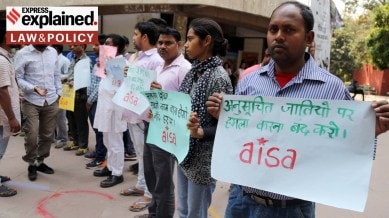Offence not committed in ‘public view’: Why Bombay HC quashed SC/ST Act case
The court held that a ‘mere insult or intimidation with a view to humiliate’ does not comprise an offence. While the incident ‘need not be in a public place, it has to be in public view’, the court said

Stating that the offences were not committed in “public view”, the Bombay High Court quashed a case under the Scheduled Caste and Scheduled Tribes (Prevention of Atrocities) Act, 1989 (SC/ST Act).
The case in question
In Afshamaskar Laikhkan Pathan vs State of Maharashtra, the complainant claims she had entered into a relationship with someone who promised to marry her. But this man got engaged to someone else. When she went to meet him, she claims that she was assaulted by the man’s relatives who hurled casteist abuses at her.
Following the incident, the complainant registered an FIR which included offences under Sections 3(1)(r) and 3(1)(s) of the SC/ST Act. Section 3(1) lists offences that may be committed by persons who are not a member of a Scheduled Caste or a Scheduled Tribe.
Section 3(1)(r) punishes someone who “intentionally insults or intimidates with intent to humiliate a member of a Scheduled Caste or a Scheduled Tribe in any place within public view”. Section 3(1)(s) punishes someone who “abuses any member of a Scheduled Caste or a Scheduled Tribe by caste name in any place within public view”.
Crucially, both provisions require the offence to be committed “in public view” in order to be prosecuted.
What the Bombay HC decided
While quashing proceedings against four accused under these provisions, a Bench of Justices Vibha Kankanwadi and Rohit Joshi stated that “mere insult or intimidation with a view to humiliate or hurling abuses in the name of caste will not constitute an offence under the said provisions”. They explained that “the incident need not be in a public place. It has to be in public view.”
The Bench referred to the Supreme Court’s ruling in Hitesh Verma vs State of Uttarakhand in 2020, in which it held that “in order to constitute offence under Section 3(1)(r) and 3(1)(s) of the Atrocities Act, the alleged insult, intimidation causing humiliation and/or act of hurling abuses must be in public view for which presence of some third person/s is essential at the time of the incident. It is further held that the existence of any independent witness who has seen the incident is essential to make out the offence under the said provisions.”
In this context, the Bombay High Court pointed out that the chargesheet and the FIR in the current case did not contain a statement from any witness who had seen the alleged incident, and that the offences under Sections 3(1)(s) and 3(1)(r) were not made out. These charges and the proceedings related to them were quashed, though other charges under the Indian Penal Code, 1860, and the SC/ST Act were allowed to remain.
The ‘public view’ argument in SC/ST Act
The Karnataka High Court dealt with a similar case in Shivalingappa B Kerakalamatti vs State Of Karnataka in September 2023. The case, heard by a Bench of Justice M Nagaprasanna, involved a complainant who was allegedly assaulted on his way to work with a cycle chain while being abused with references to his caste. However, the Karnataka HC quashed the case which included charges under Sections 3(1)(s) and 3(1)(r).
For these offences, it held that “what is necessary is hurling of abuses in a public place or in a place of public view… Whether it was in a public place or in a place of public view is not forthcoming in the statements or in the summary of the charge sheet”.
It further clarified that “Therefore, offence under the Act is not established merely on the fact that the informant is a member of Scheduled Caste”, and that there must be an intention to insult “a member of Scheduled Caste or Scheduled Tribe for the reason that the victim belongs to such caste”.
The Supreme Court has also weighed in on the “public view” requirement in recent years. In December 2024 the court set aside charges of intentional insult and intimidation under the SC/ST Act after finding that the alleged offence took place in the backyard of someone’s house, which it held “is not a place within the public view”.